As I write about quilting, sometimes I’m reminded that people new to quilting don’t understand all the terms and quilting language we use. I forget that I had to learn too. So let’s have a short primer on what a quilt is and how it’s made.
Quilt top
The quilt top is the decorative top of the quilt. It’s sewn together. Some people only enjoy this part of the process – putting together the colours, shapes and fabrics to make their quilt top. They might hand piece (sew) it or use a sewing machine. But once the top is done, they have someone else quilt it on their longarm machine. They either don’t like to quilt or they can’t. Their joy comes from making that beautiful quilt top. (There are also quilt tops that are just one large piece of cloth. These are whole cloth quilts.)
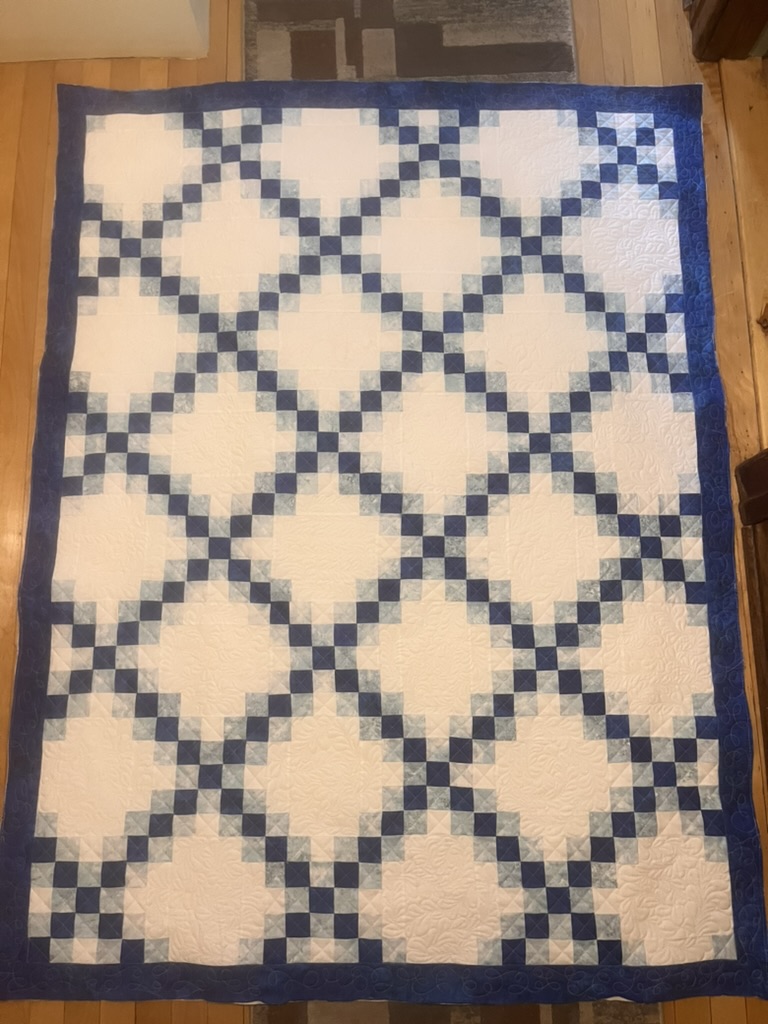
Others, like me, do both, we make the top and then quilt it.
Quilting
The act of quilting is attaching the top, the batting (the soft inner layer) and the backing together. The batting can be cotton, polyester, bamboo, wool or any combination. Some quilters may use flannel or even an old blanket. Attaching the three layers is done by tying or quilting running stitches. I’ve never tied a quilt. It involves using a long thicker thread, making a stitch through all three layers from the top to the bottom and back up to the top again, and then tying the two tail ends of the thread into a sturdy knot. The quilter does this at regular intervals across and down the quilt. It’s my understanding that not many people still tie quilts – it was done out of necessity in the past. It was a quick way to get a warm quilt ready for use, but some quilters still do it.
Quilting, on the other hand, is using a thread that sews the three layers together. There’s hand quilting, machine quilting, and longarm quilting.
Hand quilting
I began my quilting life as a hand quilter. I loved sitting and moving the needle through the fabric. I’d often watch TV while doing this or sometimes it was just a meditative act. Some hand quilting is basic, some quite intricate. As I became more practiced, my stitches got smaller and more even.

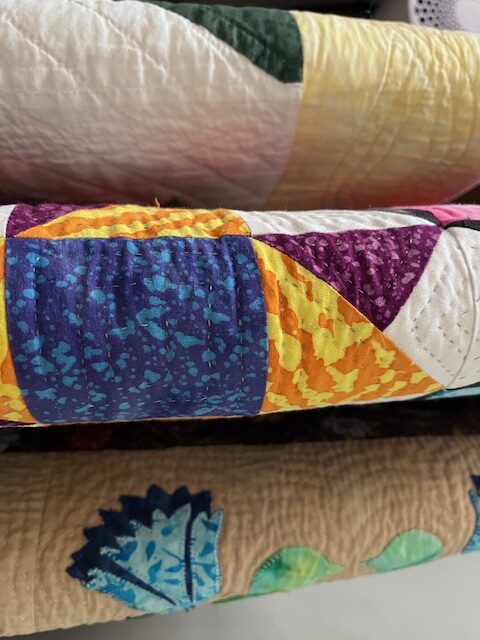
I made many quilts this way and I’m afraid I was a bit of a quilting snob at the time. I felt that hand quilting was the only true way to make a quilt. Oh how wrong I was! What I did learn was that machine quilting is not easy. It was a skill that took a lot of work to attain. And I had so many ideas and projects in mind that if I stuck with just hand quilting, I’d never have enough time to do them all.
Machine quilting
You use a regular sewing machine to do machine quilting. It takes a lot of practice to get it right and once you do, wow can you quilt a lot faster than you can by hand! But it’s also awkward. You have a large quilt, often heavy, and a small work surface. Machine manufacturers got quilt-savvy though and designed machines with larger throats (spaces between the needle and the machine itself). This allowed quilters to move their quilts through the machine more easily. Once I learned how to machine quilt, I still made some hand quilted ones though – I love the process.
I found that I didn’t love machine quilting. I found it hard on my shoulders and back, and I didn’t like being in front of my machine all the time. But it did the trick and I made some gorgeous quilts, so I kept on.
Longarm quilting
A longarm quilting machine is like a huge sewing machine but it’s on a frame. Unlike with a sewing machine where you move the fabric under a needle, with a longarm, the fabric is fixed on a frame and you move the needle. It’s like using a pen in a way. You can “draw” your quilting.
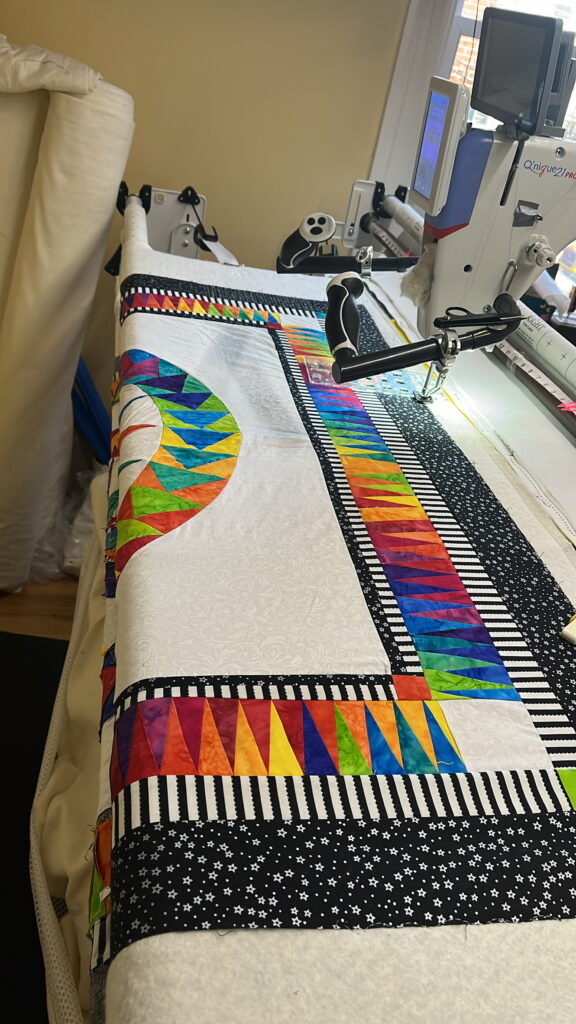

I do freehand and ruler quilting with my longarm. I enjoy the “drawing” and watching my own designs come to life in front of me, much more than I did with machine quilting. To me, this is the best part of quilting because good, creative quilting can make the most ordinary of quilt tops just come alive. I do feel that quilting itself is an art, just as piecing a quilt top together is.
Longarm quilters don’t have to rely on freehand or using rulers though. They can have robotics or computerized systems. These allow quilters to do set patterns much more quickly and much more symmetrically than doing the quilting freehand. Shops and businesses that offer longarm quilting usually have these systems, although at-home quilters do too. They’re quite expensive but well worth it for many who make a living quilting for others.
The quilting makes such a difference
I love the challenge of making a quilt top really pop. It’s just what I like to do. I’ve quilted some super intricate quilts for friends and myself. It’s an art and something I enjoy so much. But quilting can also make simpler tops look more complicated and fun. Look at this top I put together for a donation quilt for Bread and Beyond. See how ordinary the squares are before they are quilted? And see the texture and movement the quilting gave them? It took a plain quilt top and made it so much nicer. There wasn’t anything wrong with the quilt top as is, and any type of quilting would have been nice, but the choices I made really changed how the top looks.
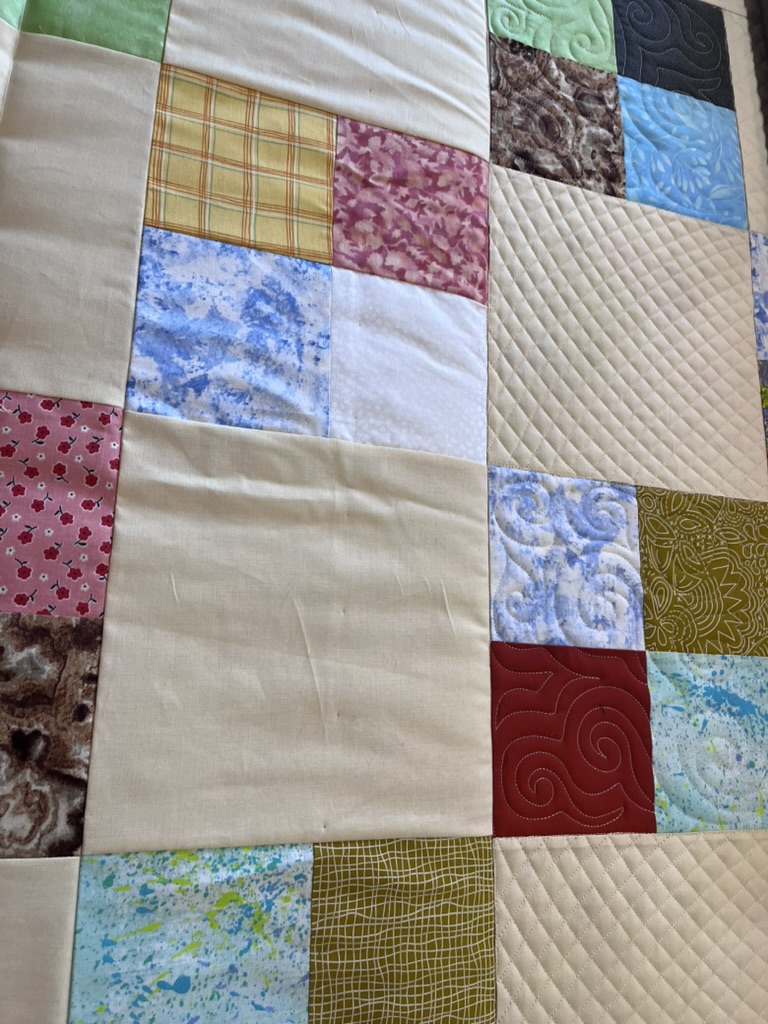
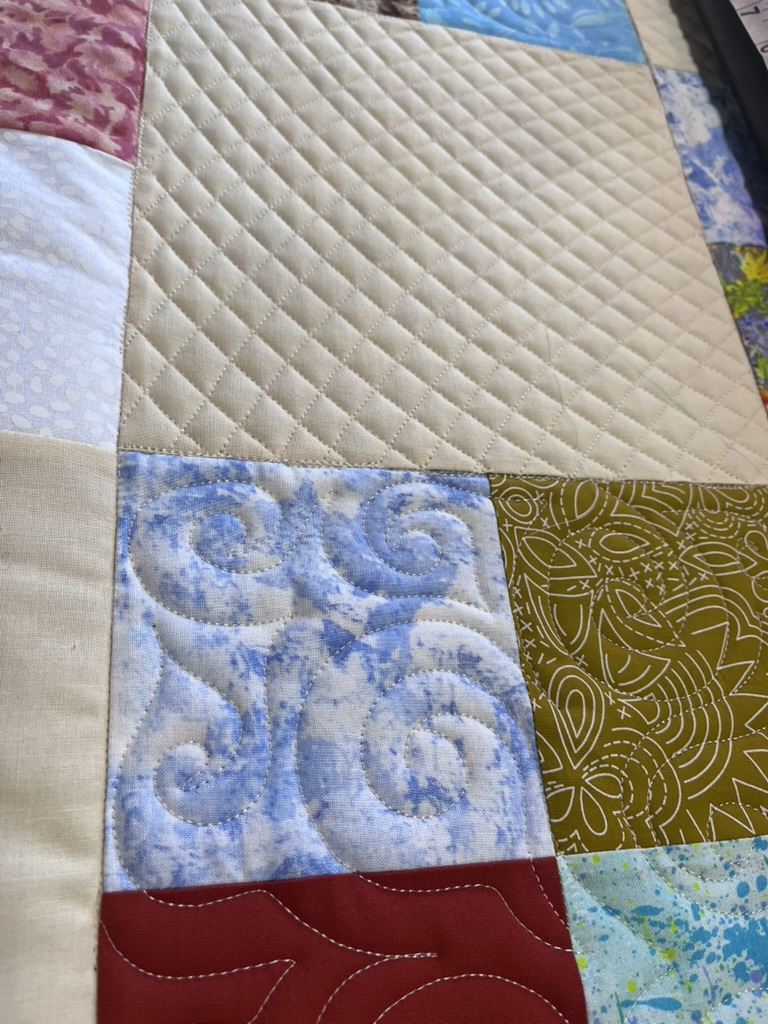
This blog post compares how quilting really punched up a fabric panel: What a Difference Quilting Makes.
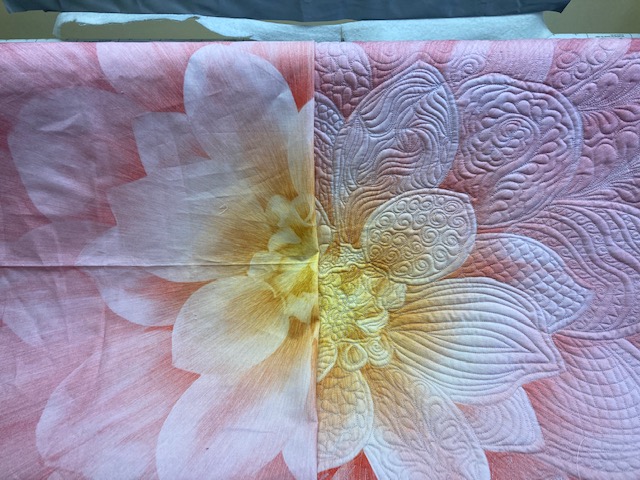
The binding
The last part of putting a quilt together is binding it. That’s putting the fabric around the edges to finish it. Most quilters sew together long strips, fold them in half, sew the binding all around to one side and then attach it to the other side. Some do it differently. They take the excess backing, fold it over, and then fold it again over the front of the quilt, sewing it down. There’s nothing wrong with doing it this way, but many quilters feel that this binding isn’t as strong as the other way. But you know what? Quilters should do what is right for them. And if that’s the way they want to bind their quilts, that’s what they should do!

Sometimes you have a quilt that you don’t want to have a binding on though. The binding could take away from the quilt. In those cases, I use a facing, which finishes the edges of the quilt without showing anything in front. You attach a wider strip of fabric as you would a binding, but you pull it all the way to the back, so nothing shows in front. I did this for my favourite zoo quilt:
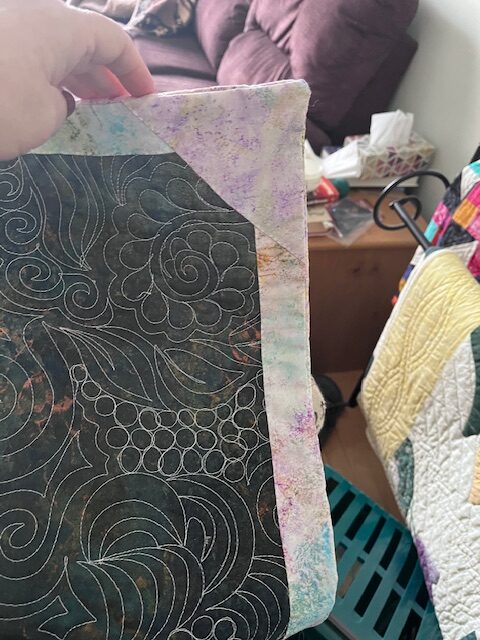
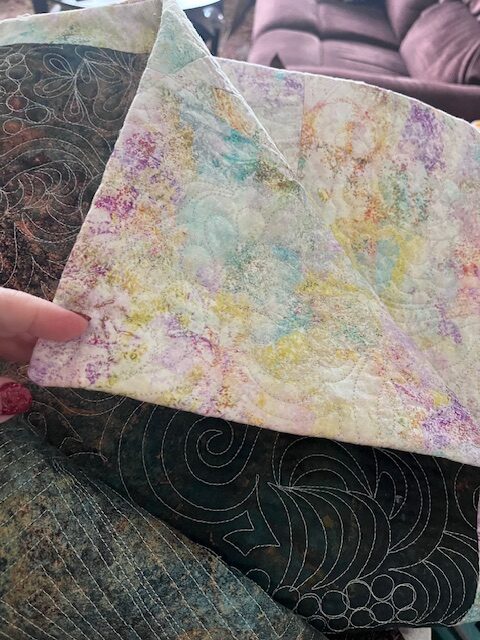
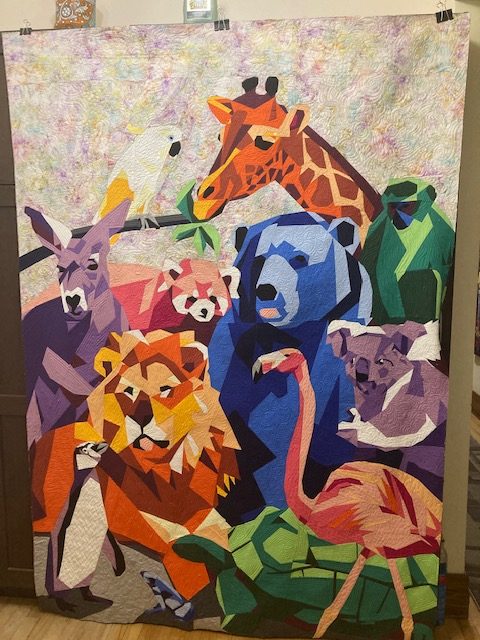
Lastly, the label
I never used to label my quilts, or if I did, it was only for special ones. But I learned over the years that we really should label all our quilts. Years from now, it’s part of our history. So I make more of an effort to do that now. The label can be very simple, who made the quilt, where, and when – and the design name if there is one. Or it can be more detailed. There are no rules. Here is the one that I made for the zoo quilt:
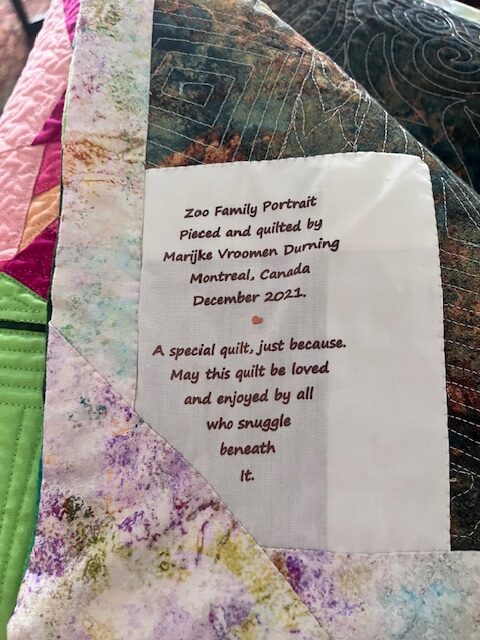
And that’s what a quilt is. Three layers, attached together, and often made with love.
